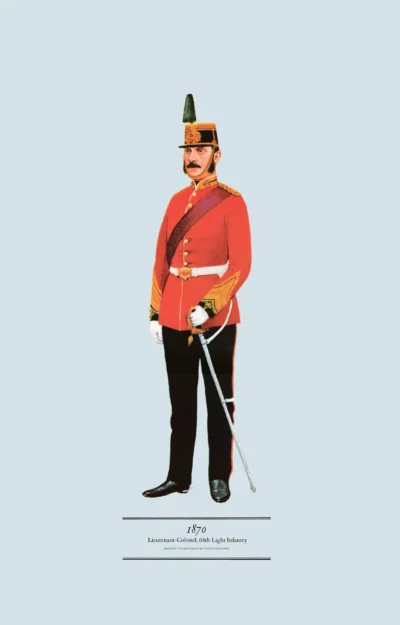Captain, Devonshire Regiment, 1896
£12.50
Raised 1667; from1881 the Devonshire Regiment; from 1958 the Devon and Dorsets; from 2007 The Rifles – RIFLES (scroll down for a more detailed Description)
Published 1970 by © Hugh Evelyn Limited; drawn by Colonel Philip Henry Smitherman (1910-1982), Royal Corps of Signals
Size: c. 24.5 x 37.5 cm [9 ½ ″ x 14 ½ ″] (may vary slightly from printers’ cut 50 years ago)
Printed on on medium cardstock weighing 144 g/sm2 faced in light greyish blue (RGB c. d4e1e8)
Print is STANDARD size – shipping is the same for 1 to 10 prints (based on largest print size in your order) – see Shipping & Returns.
In stock
Description

Since 2007 part of The Rifles Regiment. The Devonshire Regiment was raised in 1685 as the Duke of Beaufort’s Musketeers, becoming the 11th Foot later and the Devonshire Regiment in 1881. In that year they were given the white facings shown here. They had previously been green but tidy minds in the War Office decreed that Royal regiments were to have blue facings, English and Welsh regiments white, Scottish yellow, and Irish regiments green. Many regiments were affected by this order, which was very unpopular, and gradually most regiments managed to recover their original facings, including the Devons. In 1958 the regiment was amalgamated with the Dorset Regiment to form the Devonshire and Dorset Regiment which, in 2007, was amalgamated with the Royal Gloucestershire, Berkshire and Wiltshire Regiment, the Royal Green Jackets and The Light Infantry to form a new large regiment, The Rifles.
Here, an officer in the dress normally worn on duty in barracks at the end of the nineteenth century. The ‘jumper’ is made of red serge, with pockets, and has the collar and cuffs of the regimental facing colour. The crimson sash indicates that the officer is on duty. The orderly officer would wear a similar dress but with a full-dress helmet and a sword, with the sword belt under the coat. On manoeuvres an officer usually wore helmet, ‘jumper’, buff equipment with haversack and water bottle, sword and short black gaiters.
Additional information
| Weight | 0.0131 kg |
|---|---|
| Dimensions | 23 × 37 cm |





